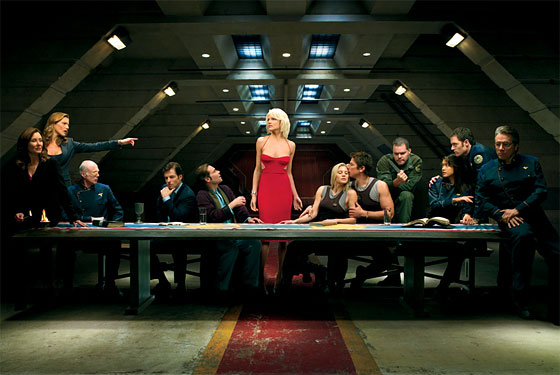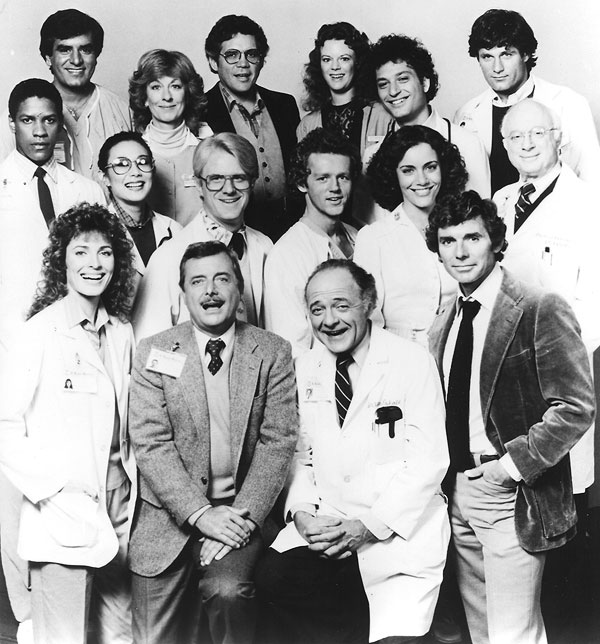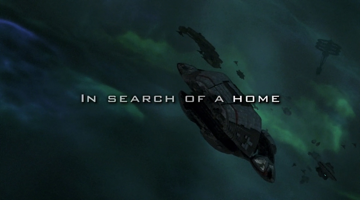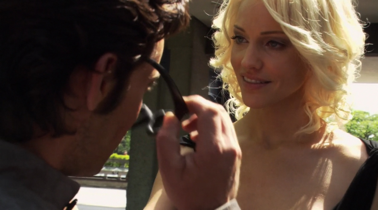Networking Families: Battlestar Galactica and the Values of Quality
Jordan Lavender-Smith / City University of New York

Any discussion of “quality TV” requires a disclaimer: “to notice a program’s signifiers of quality is not to assert anything about its value.”1 Robert J. Thompson provided an extended register of the term in 1996 to facilitate his discussion of television’s “second golden age,”2 but by 2008 he had to concede that the label had lost its qualitative heft: “About 12 years ago, I defined ‘quality TV’ with a list of a dozen characteristics. Now I can find a lot of shows on the air that exhibit all 12 characteristics but in the end, aren’t really all that good.”3 When critics call a show “quality TV,” they aren’t necessarily making an evaluative claim. Sarah Cardwell encourages us, instead, to think of the designation as a description of form: “to label something ‘quality television’ is more like making a generic classification: it is comparable to agreeing that a certain film is a Western.”4 Additionally, the label “quality TV” provokes a consideration of production and marketing in the late-network and post-network eras, those in which “quality demographics” overtook “least objectionable programming” as the industry’s dominate ethic.
All but inaugurating what came to be known as “quality TV,” MTM Enterprises produced such programs as The Mary Tyler Moore Show, The Bob Newhart Show, WKRP in Cincinnati, Hill Street Blues, and St. Elsewhere. 5
In Television’s Second Golden Age, Thompson highlights a hallmark of MTM quality television—the fictionalized upending of the traditional nuclear family: “The workplace family, whether it was in a police station, a hospital, or a Vermont inn, became a defining characteristic of nearly all of MTM’s subsequent series.”6 Jane Feuer writes that “for women especially, the alternatives presented were ideal ones, not depictions of the reality of work but images of a liberated existence that could be taken as a goal to strive towards.”7 These adventurous proposals for familial belonging marked a forward-thinking shift from the orthodoxies of Father Knows Best and Ozzie and Harriet. Still, while MTM may have been performing progressive politics, what interests me here is the fact that viewers of quality TV are often told that it’s okay to look for family elsewhere — that family is a choice. Perhaps that elsewhere is work or school or recreation, but it may also be towards television itself that we turn.

Ron Moore’s Battlestar Galactica adapts this inward gaze for the TV III era,8 widening the family’s circle to include the non-human and mechanical, or the very technologies on which the show itself depends and thrives. In 1997, David Foster Wallace suggested that TV and technology are similar in this respect: “as with television, whether we happen personally to love technology, hate it, fear it, or all three, we still look relentlessly to technology for solutions to the very problems technology seems to cause.”9 From the culturally diverse fictional characters in the workplace to the science-fictional cyborgs in space, radically conceived families are invited nightly into our homes. The representational reorganization of the family is one characteristic of many quality TV shows, and this trope has traditionally (and understandably) been understood as forward-thinking. And yet, on average, Americans watch five and a half hours of TV a day, and so I hope it’s clear that these representations are potentially generative of social and political inter-passivity , that they might represent a desire for seeing rather than being: producers’ acknowledged job is to ensure “prodigious amounts of watching,”10 and the re-ontologizing of the family to include the fictional and technological invites us to make a home of quality TV.

Battlestar spends four seasons complicating the miniseries’ good-bad dichotomy of humans and Cylons, but ultimately stigmatizes technology. The surviving characters settle an Edenic earth; the narrative then leaps ahead 150,000 years to diagnose contemporary civilization as pre-apocalyptically technology-obsessed. Shaun Huston writes, “the organic must be protected from the mechanical,” which is a “difficult conclusion to accept within the terms of the series.”11 This corresponds to the paradoxical ethos of many dystopian narratives—the tendency to spend the majority of the narrative glamorizing something, only to use the slight balance condemning it. If viewers take Battlestar’s final message to heart, then their next order of business would be to chuck their DVRs and DVDs into the fireplace. We should amend Huston’s insightful conclusion: it’s not just the years-long narrative that make Battlestar’s ending so difficult to stomach, but the fact that we receive this message via advanced technology, or the very thing that the show disavows. Galactica’s interrogation of post-nuclear family mechanics and what it means to be human was potentially groundbreaking, but by the show’s end the reconstitution of the family breaks down, and a thick line is drawn between the natural and artificial, delivering an outmoded humanism through posthuman technologies.

Ron Moore and company exercise the political flexibilities of quality TV’s tropes, those that critics often consider inherently progressive. A convention related to the reorganization of the family is the hour-long drama’s multiple storylines, or plot threads, which often weave ornate social tapestries. Anyone who watches an episode of Battlestar, The Wire, or The Sopranos without having seen every episode of the series will quickly realize that they’re missing a lot of important information about characters’ interpersonal relationships and that constant contact is a must. To some extent, this might also be true when we watch Cheers or Buffy the Vampire Slayer, but I think it’s clear that primetime social complexity of Battlestar’s magnitude is a recent phenomenon, one aided by the increasing ease with which we’re able to pause, rewind, and re-watch. The complexity that characterizes TV III quality is the result of an ever-deepening seriality, one tied as much to Moore’s Law as it is to literary tradition. The channel-navigation button and cable operators stuffing their lineups with hackneyed reruns made way for the pause and rewind buttons and online message boards: these technological shifts generate broad aesthetic trends in primetime televised entertainment, from intertextual irony in the late 80s and 90s to serialized, intratextual sincerity in the 00s.
An obvious consequence of deepened seriality/familiarity and “increased social network complexity”12 is that we “acknowledge that all perspectives are partial, colored by place and context, and that we must seek knowledge of all points of view before making judgments.”13 We’re hard-pressed to identify pure villains on TV III quality programming; instead, we sympathize with characters that had been relegated to the ethical sidelines on network television—Tony Soprano, Stringer Bell, Dexter Morgan, et al.
Consequently, Ron Moore’s project is to make viewers experience an uneasy empathy for the non-traditional, and for difference more generally. Gaius Baltar (James Callis) is partly responsible for his worlds’ destruction, and yet he isn’t all bad; audiences take pleasure in his squirming, and Callis’s performance is often charmingly comic. According to Battlestar producer David Eick, audiences’ emotional proximity to Gaius is “a bizarre place to be.”14 However, our nearness isn’t troubled simply because Gaius (at least superficially) resembles a conventional villain. In addition to this emotional proximity, the audience also experiences a perspectival proximity with and beyond Gaius: for example, responsibility for the Cylon attack is a secret, one that only audiences and the Cylon Number Six (Tricia Helfer) share. Likewise, viewers are able to see Gaius’s “angel” Six, even though other characters can’t. Battlestar’s audience, then, has access to a point of view above the text, or above the web of relations. Complicating the viewer’s position, Laura Roslin (Mary McDonnell) learns she has cancer the day that the Cylons attack; our knowledge of her secret, again, underlines an access to information that exceeds any single character’s perspective. However, Roslin reveals her secret, and viewers are told that the disclosure (or, simply, the act of disclosure) is healthy. Gaius doesn’t confess his culpability, preserving our narrative advantage.
Thus, audiences are in the “bizarre place” of acknowledging that Gaius’s confession is one that the rest of the community has the right to hear, even while we pray that Gaius won’t undermine our position above the web of relations. Conceivably, an aerial view focuses viewers’ attention on the systemic, as opposed to the individual. Clearly, though, our ‘objective’ point of view can just as easily provoke totalitarian sentiments. Quality TV shows have succeeded in creating an isolated point of view above the network, challenging any suggestion that audiences desire to be just one member of a social system. The viewer wants to belong to a network, as long as she can rise above it.

Still, much like the conceptual movement of the family from the conservative essentialist model of Leave it to Beaver to the more liberal constructivist model of Mary Tyler Moore, “intertwined subplots,” writes Susan Hayward, “work to unite disparate characters, overcoming differences of class, race, and gender and forging communities within the text that echo the reading communities outside it.” (Hayward, 4)) Though Hayward’s Consuming Pleasures has been invaluable to my own research, it’s important to remember that audiences are segmented and targeted by stations along the very lines that Hayward finds blurring, and multicultural casting doesn’t necessarily exist to attract a multicultural viewership. The novel coexistence of disparate groups under the auspices of quality TV’s narrative organization, then, must reflect a progressive desire for representations of radically conceived communal being. And television itself is where one can continually, or serially, turn to have this desire met.
Acknowledgements:
The author wishes to thank Dr. Heather Hendershot for her invaluable help on this project.
Author Bio:
Jordan Lavender-Smith is pursuing his Ph.D. in English and Film Studies at the City University of New York’s Graduate Center. His academic interests include self-reflexivity in literature and film, seriality and addiction, Early- and Post-modern dramaturgy, and, more generally, the cultural causes and consequences of literary forms. He teaches in the English department at the City University of New York’s Queens College.
Image Credits:
1. Battlestar Galactica: Season 4 Promotional Photo
2. St. Elsewhere: Family Portrait
3. From Battlestar’s opening titles (Author screen capture)
4. Capt. Lee Adama / Earth (Author screen capture)
5. Gaius Baltar and Cylon Number Six (Author screen capture)
- Cardwell, Sarah. “Is Quality Television Any Good?” McCabe, Janet, and Kim Akass (eds). Quality TV: Contemporary American Television and Beyond. London: I.B. Tauris, 2007 (20-34), 29. [↩]
- Thompson’s twelve characteristics of a “quality TV” show: 1) it’s “not ‘regular’ TV . . . . [It] breaks rules”; 2) it “usually has a quality pedigree”; 3) it attracts “blue chip demographics”; 4) it will often “undergo a noble struggle against profit-mongering networks and nonappreciative audiences”; 5) it “tends to have a large ensemble cast”; 6) it “has a memory”; 7) it “creates a new genre by mixing old ones”; 8) it “tends to be literary and writer-based”; 9) it “is self-conscious,” making “oblique allusions” to “both high and popular culture”; 10) its “subject matter . . . tends toward the controversial”; 11) it “aspires toward ‘realism’”; 12) it is “showered with awards and acclaim.” Television’s Second Golden Age: From Hill Street Blues to ER. New York: Continuum, 1996, 15. [↩]
- Thompson, Robert J. “Preface.” McCabe, Janet, and Kim Akass (eds). Quality TV:
Contemporary American Television and Beyond. London: I.B. Tauris, 2007 (xvii-xx), xx. [↩] - Cardwell, 21. [↩]
- “The company was like a college where the writing, producing, and directing of quality TV was taught, learned, and executed by such graduates” as James L. Brooks, James Burrows, Glen and Les Charles, David Lloyd, Steven Bochco, Bruce Paltrow, Dick Wolf, Tom Fontana, and David Milch (Thompson, 1996, 46). [↩]
- Thompson, 1996, 49. [↩]
- Feuer, Jane, Paul Kerr, and Tise Vahimagi. MTM: “Quality Television”. London: BFI Pub, 1984, 59. [↩]
- For more on the “three eras” of TV, see http://www.brandthat.tv/2008/09/what-is-tv-iii.html [↩]
- Wallace, David Foster. “E Unibus Pluram: Television and U.S. Fiction,” in A Supposedly Fun Thing I’ll Never Do Again: Essays and Arguments. Boston: Little, Brown and Co, 1997, 57. [↩]
- Wallace, 38. [↩]
- Huston, Shaun. “Thinking through the BSG finale.” Short-Circuit Signs. March 25, 2009. http://olympus_mons.typepad.com/short_circuit_signs/2009/03/thinking-through-the-bsg-finale.html (Accessed on April 14, 2009). [↩]
- Johnson, Steven. Everything Bad Is Good for You: How Today’s Popular Culture Is
Actually Making Us Smarter. New York: Riverhead Books, 2005, 169. [↩] - Hayward, Jennifer. Consuming Pleasures: Active Audiences and Serial Fictions from Dickens to Soap Opera. Lexington: University Press of Kentucky, 1997, 13. [↩]
- Eick, David. Battlestar Galactica, Miniseries DVD Commentary. [↩]
I think it’s also important to acknowledge regarding the show’s conclusion that the “family” within the show (the characters who went on this journey together) are scattered across the continent, becoming nomads amidst the fields. As such, we are the only link that exists between them once they head off to their secluded islands or walk off into their grassy paradise. They end much as they began, a series of individuals with their own dreams and goals who are forced to become a family (or at least give the appearance of becoming a family) while fighting against a common threat (and by our presence in their lives, sharing with each of them an important dialogue – the visions extend from Gaius/Six to smaller examples like Starbuck and her father or even our knowledge of Sharon’s Cylon identity as she interacts with an ignorant Helo on occupied Caprica). There are numerous moments when the show actually has everyone realize they belong to a sort of family, overcoming being divided by elections or mutinies and forcing themselves back together more damaged than ever before. Heck, New Caprica itself was an effort by the Cylons to unite their family (Parent and Child, Human and Cylon) back together as it was before, and it failed as miserably as every other attempt (but that final, idealistic and romantic one) to bring everyone together with a common goal.
The question now is what we make of the upcoming Caprica – by its nature, it tells the story of two families, one of which has a cyborg for a daughter, but to what degree will these grander ideas of family and unity be disrupted by the more familiar urban environment the show exists in? Space and the survivalist nature of BSG’s narrative forced a sense of unity that brought these sorts of complexities to the surface, but Caprica doesn’t exist in the same world, and may be able to present its own unique take on the material as a result.
Pingback: Digital Culture Links: December 6th 2009 « Tama Leaver dot Net
Fantastic article. As an avid consumer of serial narratives, it is always interesting to see critics and scholars interrogate the role or position of the nuclear family on television these days. The aughts arguably featured some of the most profound and complex meditations on the family unit—ranging from The Sopranos to Arrested Development. In fact in terms of “quality TV,” many of this decade’s most venerated shows center on the nuclear family in a state of panic. Being “normal” is the goal. But reaching that goal is no longer a matter of keeping external forces at bay. On television today, it seems that keeping the family in tact requires a constant negotiation between personal values and societal pressures. “The fictionalized upending of the traditional nuclear family,” that began to show its face in the 90s has now found its voice on cable. Networks continue to rework and play with the traditional paradigms. Shows like Modern Family, for example, tend to uphold neoconservative values albeit through a liberal façade. On cable, however, the assault on “traditional family values” is in full swing. In this decade, the family is presented as “upended” from the very beginning. And the narratives therefore revolve around trying to disguise these “abnormalities.” For the last ten years, the term quality TV has become almost synonymous with these familial narratives, presenting audiences with these “abnormal” families trying to cope with an ever-impeding modern world. Shows like Big Love, United States of Tara, Hung, and Sons of Anarchy (I could go on) all directly address the construction and subsequent destruction of the nuclear family through cultural roadblocks ranging from polygamy to mental illness to male prostitution. It is not about preserving the family anymore. Its about trying to fit in or “act as if.” (Hence all of the children on these shows’ repeatedly crying, “I just want to be normal.”) In the end, we come to see how these abnormal families are much like our own, but at the same time we feel comforted by the fact that we don’t have to deal with the dramatic problems that come with polygamy for example.
In terms of BSG, I think the show’s treatment of the family is surprisingly nuanced as man mates with machine and vice versa. The search for a home subsequently becomes a search for family, as the survivors of the 12 colonies seek solace in settlement. Yet, what makes BSG so interesting is the show’s ability to push the allegory a bit further back, making audiences work a little harder and dig a bit deeper. Much like Avatar, the anti-technological stance proposed by the end of BSG is complicated by “the fact that we receive this message via advanced technology, or the very thing that the show disavows.” But unlike Avatar, BSG takes the time to interrogate some of the subtleties that go into the formation of the nuclear family. The role of religion, for example, becomes an interesting inflection point between the cylons and the humans. I supposed we have to ask ourselves; does this term “quality” refer simply to complexity? Or does it refer more to an ability to blend complexity with the simple pleasures of serial drama? If a show wishes to be a quality program, it seems that it must always straddle this line.